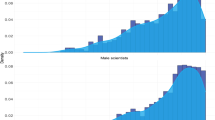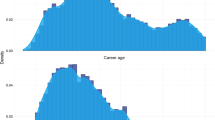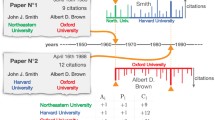Abstract
We investigate the question of how long top scientists retain their stardom. We observe the research performance of all Italian professors in the sciences over three consecutive four-year periods, between 2001 and 2012. The top scientists of the first period are identified on the basis of research productivity, and their performance is then tracked through time. The analyses demonstrate that more than a third of the nation’s top scientists maintain this status over the three consecutive periods, with higher shares occurring in the life sciences and lower ones in engineering. Compared to males, females are less likely to maintain top status. There are also regional differences, among which top status is less likely to survive in southern Italy than in the north. Finally we investigate the longevity of unproductive professors, and then check whether the career progress of the top and unproductive scientists is aligned with their respective performances. The results appear to have implications for national policies on academic recruitment and advancement.


Similar content being viewed by others
Notes
The complete list is accessible on http://attiministeriali.miur.it/UserFiles/115.htm, last accessed November 14, 2016.
Mathematics and computer sciences, Physics, Chemistry, Earth sciences, Biology, Medicine, Agricultural and veterinary sciences, Civil engineering, Industrial and information engineering.
http://cercauniversita.cineca.it/php5/docenti/cerca.php, last accessed November 14, 2016.
Abramo et al. (2012a) demonstrated that the average of the distribution of citations received for all cited publications of the same year and subject category is the most effective scaling factor.
It must be noted that different fractional counting across disciplines does not cause any bias, because the top 10% scientists are extracted from each field. To exemplify, if we did not weight the authors’ contribution in Cardiology, the top 10% scientists in cardiology might change, but all the remaining top scientists (from the other fields) would be exactly the same.
In order to check the consistency of the results, we adopt also another definition of TS, as the one whose performance falls above the mean of the subpopulation above the first mean of the overall population in their SDS, by the CSS technique (Glänzel and Schubert 1988).
Concerning the intersections of two periods, we repeated the analyses but relaxing the constraint that the TSs must be on staff from three periods to two periods. Under this changed condition, the share of those who maintained their stardom for two periods resulted exactly the same as in Table 1.
We did not conduct the UN analysis at discipline level, since the differences in shares of UNs are heavily affected by WoS coverage and by publication behaviors unique to the disciplines (Abramo et al. 2015).
http://www.ansa.it/sito/notizie/topnews/2016/09/23/cantone-allarme-corruzione-universita_687f391c-802c-478b-b9e4-6d4f3c1b8f0d.html, last accessed November 14, 2016.
References
Abramo, G., Cicero, T., & D’Angelo, C. A. (2011). Assessing the varying level of impact measurement accuracy as a function of the citation window length. Journal of Informetrics, 5(4), 659–667.
Abramo, G., Cicero, T., & D’Angelo, C. A. (2012a). Revisiting the scaling of citations for research assessment. Journal of Informetrics, 6(4), 470–479.
Abramo, G., Cicero, T., & D’Angelo, C. A. (2013a). The impact of unproductive and top researchers on overall university research performance. Journal of Informetrics, 7(1), 166–175.
Abramo, G., & D’Angelo, C. A. (2014). How do you define and measure research productivity? Scientometrics, 101(2), 1129–1144.
Abramo, G., & D’Angelo, C. A. (2016a). A farewell to the MNCS and like size-independent indicators. Journal of Informetrics, 10(3), 646–651.
Abramo, G., & D’Angelo, C. A. (2016b). A farewell to the MNCS and like size-independent indicators: Rejoinder. Journal of Informetrics, 10(3), 679–683.
Abramo, G., D’Angelo, C. A., & Caprasecca, A. (2009). The contribution of star scientists to overall sex differences in research productivity. Scientometrics, 81(1), 137–156.
Abramo, G., D’Angelo, C. A., & Cicero, T. (2012b). What is the appropriate length of the publication period over which to assess research performance? Scientometrics, 93(3), 1005–1017.
Abramo, G., D’Angelo, C. A., & Rosati, F. (2013b). The importance of accounting for the number of co-authors and their order when assessing research performance at the individual level in the life sciences. Journal of Informetrics, 7(1), 198–208.
Abramo, G., D’Angelo, C. A., & Rosati, F. (2015). The determinants of academic career advancement: evidence from Italy. Science and Public Policy, 42(6), 761–774.
Abramo, G., D’Angelo, C. A., & Rosati, F. (2016). The North–South divide in the Italian higher education system. Scientometrics. doi:10.1007/s11192-016-2141-9.
Azoulay, P., Zivin, J. S. G., & Wang, J. (2010). Superstar extinction. Quarterly Journal of Economics, 125(2), 549–589.
Burrell, Q. L. (2003). Predicting future citation behavior. Journal of the American Society for Information Science and Technology, 54(5), 372–378.
D’Angelo, C. A., Giuffrida, C., & Abramo, G. (2011). A heuristic approach to author name disambiguation in bibliometrics databases for large-scale research assessments. Journal of the American Society for Information Science and Technology, 62(2), 257–269.
Daniele, V., & Malanima, P. (2011). Il divario Nord-Sud in Italia, 1861–2011 (Vol. 273). Soveria Mannelli: Rubbettino Editore. ISBN 9788849831290.
Gerosa, M. (2001). Competition for academic promotion in Italy. Lancet, 357(9263), 1208.
Glänzel, W., & Schubert, A. (1988). Characteristic scores and scales in assessing citation impact. Journal of Information Science, 14(2), 123–127.
Hess, A., & Rothaermel, F. T. (2012). Intellectual human capital and the emergence of biotechnology: Trends and patterns, 1974–2006. IEEE Transactions on Engineering Management, 59(1), 65–76.
ISTAT (2015). Conti economici territoriali. Last accessed on 14 Nov 2016 at http://www.istat.it/it/archivio/148152
Lee, S., & Bozeman, B. (2005). The impact of research collaboration on scientific productivity. Social Studies of Science, 35(5), 673–702.
Levin, S. G., & Stephan, P. E. (1991). Research productivity over the life cycle: Evidence for academic scientists. The American Economic Review, 81(1), 114–132.
Link, A. N., Siegel, D. S., & Bozeman, B. (2007). An empirical analysis of the propensity of academics to engage in informal university technology transfer. Industrial and Corporate Change, 16(4), 641–655.
Long, R., Crawford, A., White, M., & Davis, K. (2009). Determinants of faculty research productivity in information systems: An empirical analysis of the impact of academic origin and academic affiliation. Scientometrics, 78(2), 231–260.
Merton, R. K. (1968). The Matthew effect in science. Science, 159(3810), 56–63.
Miller, J. C., Coble, K. H., & Lusk, J. L. (2013). Evaluating top faculty researchers and the incentives that motivate them. Scientometrics, 97(3), 519–533.
Nowell, A., & Hedges, L. V. (1998). Trends in gender differences in academic achievement from 1960 to 1994: An analysis of differences in mean, variance, and extreme scores. Sex Roles, 39(1), 21–43.
Perotti, R. (2008). L’università truccata. Torino: Einaudi. ISBN 9788806193607.
Petersen, A. M., Fortunato, S., Pan, R. K., Kaski, K., Penner, O., Rungi, A., et al. (2014). Reputation and impact in academic careers. Proceedings of the National Academy of Sciences, 111(43), 15316–15321.
Petersen, A. M., Jung, W. S., Yang, J. S., & Stanley, H. E. (2011). Quantitative and empirical demonstration of the Matthew effect in a study of career longevity. Proceedings of the National Academy of Sciences, 108(1), 18–23.
SVIMEZ (2015). Rapporto SVIMEZ 2015 sull’economia del Mezzogiorno. Last accessed on 14 Nov 2016 at http://www.svimez.info/index.php?option=com_content&view=article&id=348&Itemid=127&lang=it.
Viesti, G. (2015). Nuovi divari. Un’indagine sulle Università of the Nord e del Sud. Rapporto RES (Istituto di Ricerca Economia e Società in Sicilia). Last accessed on 14 Nov 2016 at http://www.resricerche.it/media/allegati/sintesi%20della%20ricerca_2015.pdf
Zucker, L. G., & Darby, M. R. (1997). Present at the biotechnological revolution: Transformation of technological identity for a large incumbent pharmaceutical firm. Research Policy, 26(4–5), 429–446.
Zucker, L. G., Darby, M. R., & Torero, M. (2002). Labor mobility from academe to commerce. Journal of Labor Economics, 20(3), 629–660.
Author information
Authors and Affiliations
Corresponding author
Additional information
An erratum to this article is available at http://dx.doi.org/10.1007/s11192-017-2255-8.
Rights and permissions
About this article
Cite this article
Abramo, G., D’Angelo, C.A. & Soldatenkova, A. How long do top scientists maintain their stardom? An analysis by region, gender and discipline: evidence from Italy. Scientometrics 110, 867–877 (2017). https://doi.org/10.1007/s11192-016-2193-x
Received:
Published:
Issue Date:
DOI: https://doi.org/10.1007/s11192-016-2193-x




